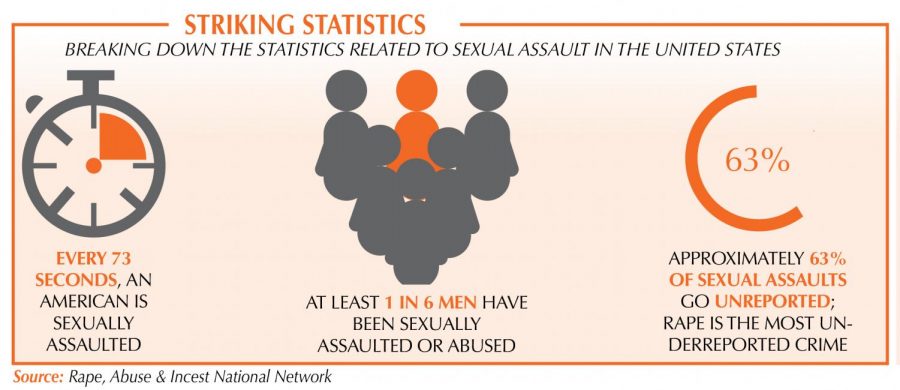#MeToo: The Forgotten Victims
Women assaulting men, it’s more common than you think
When one thinks of sexual abuse, the typical image that comes to mind is a man overpowering a woman, but in reality, women are the perpetrators of these assaults more often than one thinks.
Federal agency data from 2017 show that 2.2% of all sexual assault cases involve female perpetrators, and 79.2% of male victims report that a woman was their assaulter. While that may be true of reported sex crimes, according to a 2016 study of violent crimes by the national Bureau Justice Department, nearly 80% of all sex crimes go unreported.
With this underreporting of sexual abuse in mind, the number of female perpetrators of sexual assault is unknown but is thought to be quite a bit higher than official statistics make it out to be. Additionally, the Center for Disease Control released statistics in 2011 saying that men are almost equally as likely to experience sexual violence as women.
Just because the idea of male victims being overlooked is being brought to light, it does not mean that there isn’t any. It doesn’t mean that women’s sexual assault cases are unimportant or that they should be made unimportant. It means that all sexual assault cases are important— men and women’s.
The struggles of men and women are “a lot closer than any of us would expect,” Director of the University of California, Los Angeles’ Health and Human Rights Law Project Lara Stemple published in her 2017 article ‘Sexual Victimization perpetrated by women: Federal data reveal surprising prevalence.”
The struggles are so close, but most people do not view them with the same severity. Both the struggles of men and women are equally important and should be viewed that way.
There are many reasons that these crimes go unreported, but for men specifically, the rates of unreported sexual assault are higher than that of women. According to a University study, possible reasons for this includes the social constructions of masculinity which could cause men to not speak up specifically when the perpetrators are female.
These biases based on the gender of both the perpetrator and the victim are most prevalent when examining cases of teachers assaulting students.
When comparing the headlines of articles reporting on the sexual assault of a male student by a female teacher and of articles reporting on the assault of a female student by a male teacher, there are glaring differences in how the cases are presented.
Take these real headlines that involve a female perpetrator: “Darlington County teacher charged with having sex with a student” from Jan. 13 from the Hartsville Messenger. Another headline is: “Former North Iowa teacher gets probation for sex with a student,” from Jan. 14 from KMIT3 News. The phrasing in the statement “for sex” rather than for sexual assault or rape is not uncommon with female perpetrators.
Another headline from ABC6 on Nov. 13, 2019 states “Former Delaware County teacher indicted for having sex with 13-year-old student.” Again, the offender in this situation is a woman.
These headlines all exemplify a casual downplaying of sexual assault when it is at the hands of a female perpetrator.
News headlines are not the only evidence of the bias toward female sexual assault perpetrators. The common image of sexual assault being a man assaulting a woman is evidence that the thought of a female assaulter is rarely discussed.
“Contemporary depictions of sexual victimization reinforce the stereotypical sexual victimization paradigm, compromising male perpetrators and female victims. As we demonstrate, the reality concerning sexual victimization and gender is more complex,” an article by the American Journal of Public Health stated.
Stereotypes about women “include the notion that women are nurturing, submissive helpmates to men,” authors of the ‘Sexual Victimization Perpetrated by Women: Federal Data Reveal Surprising Prevalence’ published.
There is also a bias seen for the victims. When a man gets assaulted by a woman, the reactions are often recognition of the trauma being imposed by sexual assault than when a woman is assaulted.
The legal definition of rape was “the carnal knowledge of a female, forcibly and against her will” up until 2013, when it was changed to include both genders. The fact that men were written to be included in the definition only after the fact shows that male victims are often an afterthought in the conversation about sexual assault.
Fortunately, this issue has been gaining more attention due to various news sources and researchers.
Authors of the ‘Sexual Victimization Perpetrated by Women: Federal Data Reveal Surprising Prevalence’ claim that in a perfect world, or at least in a better one, reactions to sexual victimization would be equal for “all victims and perpetrators, regardless of sex.” And I wholeheartedly agree.


